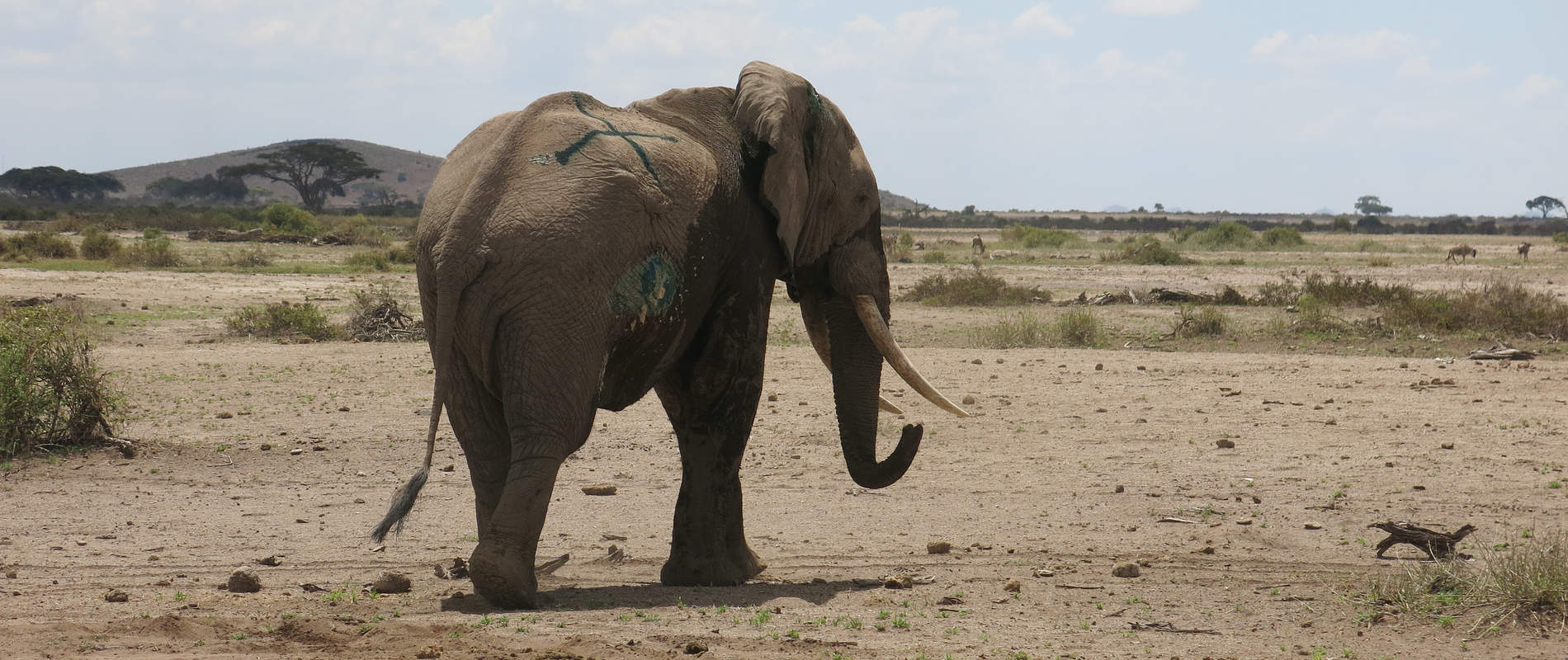MONTHLY REPORT - VETERINARY INTERVENTIONS FOR THE SOUTHERN CONSERVATION AREA (MVU) – NOVEMBER 2015 Report by Dr
MONTHLY REPORT - VETERINARY INTERVENTIONS FOR THE SOUTHERN CONSERVATION AREA (MVU) – NOVEMBER 2015
Report by Dr. Michael Njoroge
Introduction
The Amboseli ecosystem has had a long dry spell leading to possible malnutrition and death of wildlife in this region. A series of wildlife deaths have been reported but this has gradually reduced towards the end of the month possibly owing to the rains which have turned the area to a very green area with plenty of feed for the wild life. Few cases of human- wildlife conflict have been reported after the rains began.
CASE#1 POST-MORTEM OF ELEPHANT
Date of post-mortem: 10th November 2015
Species: Elephant
Age: 25-30 years
Sex: Female
Location: Amboseli
History
The death of an elephant at the Amboseli National Park had been reported to the SCA mobile veterinary team. A post-mortem was carried out and the following was observed.
General and Physical examination of the carcass
On general examination, the animal was in poor body condition and was on left lateral side. Both tusks were present.
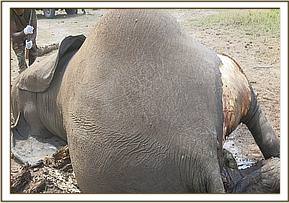
Examination of the opened carcass
The carcass had been mauled by scavengers and most of the organs destroyed. The G.I.T system had very little ingesta showing that the elephant had been off feed for a considerable period.
The tusks were recovered and handed over to the Amboseli national park headquarters for safe custody.
Samples collected
-Feacal sample from the g.i.t
-Liver sample
Differential diagnosis
Bacterial/viral infection and Malnutrition
CASE#2 POST-MORTEM OF AN ELEPHANT
Date of post-mortem: 11th November 2015
Species: Elephant
Age: 30-35 years
Sex: Female
Location: Amboseli
History
An elephant carcass was reported to have been seen within the Amboseli ecosystem within the community land.
General and Physical examination of the carcass
The carcass was about 1 month old and no viable post-mortem could be carried out. Both tusks were missing though it was evident that they were easily pulled off after decomposing of the carcass. No traumatic concussions could be seen in the tusk region and the entire carcass.
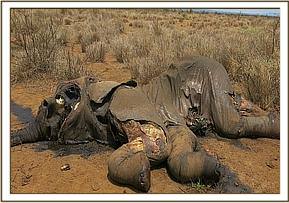

CASE#3.TREATMENT OF A SPEARED ELEPHANT
Date: 11th November 2015
Species: Elephant
Sex: Male
Age: 15-20yrs
Location: Amboseli National Park
History
This adult male elephant was spotted within the park by The Amboseli elephant research personnel while on their routine programme. A serious freshly inflicted wound was clearly visible. The vet team attended to the case and a decision was made to immobilize and treat the elephant Darting was relatively easy from a land cruiser.
Immobilization, examination and treatment
The elephant was immobilized using 17 mgs Etorphine Hydrochloride in a 3cc dart using the Dan-inject system from the land cruiser. Full immobilization took place after 5 minutes and he fell on lateral recumbence. The trunk was maintained patent using a piece of stick placed across the nostril entrances. The ears were used as blindfold. Plenty of water was doused on the ears (pinnae) and the entire body to help cool the elephant during the operation.
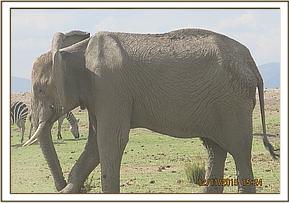

On examination, the elephant had a serious wound to the spinal region about 5 cm from the spine. The wound was deep (aprox. 70 cm), with a clean cut. It is likely to have been caused by a spear thrown from a platform.


The wound was thoroughly cleaned using water and Hydrogen Peroxide. It was then lavaged using tincture of Iodine. Topical antibiotic cream, spray and green clay was then applied into the wound to facilitate healing and avoid infection. The elephant was then injected with 200 ml Amoxcycillin L.A 20% and 100 ml Flunixine meglumine at different sites intramuscularly. The entire operation lasted about 40 minutes.
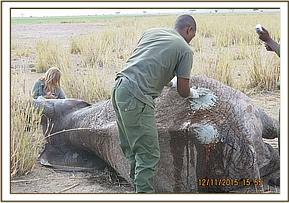

Reversal
The anaesthetic was reversed using Diprenorphine Hydrochloride (54mgs) into the ear vein.
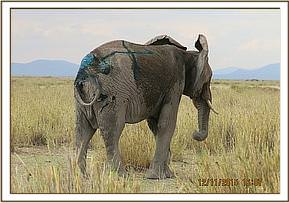

Prognosis
Prognosis is good
CASE#4 TREATMENT OF A SPEARED ELEPHANT
Date: 13th November 2015
Species: Elephant
Sex: male
Age: 40-50 yrs
History
This adult male elephant had been treated earlier for a serious right flank spear injury. Due to the severity of the wound a repeat treatment was necessary on this elephant. After several days of a thorough search, the elephant was spotted and the veterinary team immediately notified. Darting was relatively easy from a land cruiser since the ground was relatively open.


Immobilization, examination and treatment
The elephant was immobilized using 17 mgs Etorphine Hydrochloride in a 3cc dart using the Dan-inject system.
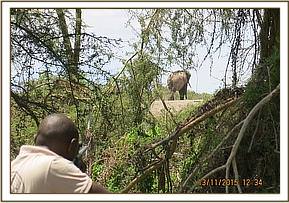

Full immobilization took place after 8 minutes and he fell in a dog sitting position. The rangers helped flip the elephant to left lateral recumbence for easy access to the wound and safety of the elephant. The trunk was maintained patent using a piece of stick placed across the nostril entrances. The ears were used as blindfold. Plenty of water was doused on the ears (pinnae) and the entire body to help cool the elephant during the operation.
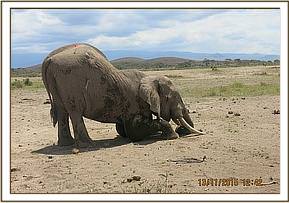

On examination, the wound was on its way to recovery and the condition had greatly improved. A fresh wound was also visible to the ear. The dead tissue was debrided and removed.
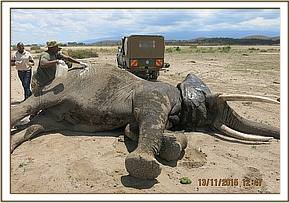
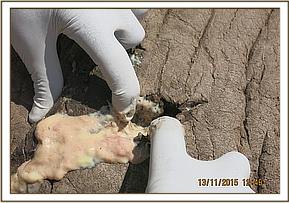


The wounds were then thoroughly cleaned using water and Hydrogen Peroxide and lavaged using tincture of Iodine. Topical antibiotic cream, spray and green clay was then applied into the wound to facilitate healing and avoid infection. The elephant was then injected with 100 ml Amoxcycillin L.A 20% and 100 ml Dexamethasone HCL at different sites intramuscularly. The entire operation lasted about 20 minutes.
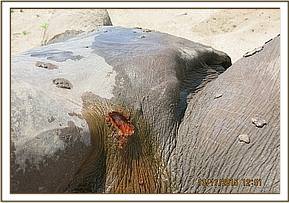

Reversal
The anaesthetic was reversed using Diprenorphine Hydrochloride (54mgs) into the ear vein. It took about 5 minutes to be fully awake from the anaesthesia and walk away from the site.


Prognosis
Prognosis is good
CASE#5 TREATMENT OF A SPEARED ELEPHANT
Date: 15th November 2015
Species: Elephant
Sex: Male
Age: 25-30 yrs
Location: Sato - Amboseli
History
The KWS reported to have spotted a male elephant with a suspected spear in the right hind quarters. Aided by the DSWT Helicopter, a thorough search ensued. The elephant was finally spotted in thick bush and in the midst of its family. At the best convenience darting was done and attempts made to drive him to some open ground. Unfortunately, the elephant went down in a sternal position in a thick bush. Quick effort was made to have the animal secured to proper lateral recumbence aided by use of a land cruiser.
Immobilization, examination and treatment
The elephant was immobilized using 16 mgs Etorphine Hydrochloride in a 3cc dart using the Dan-inject system from the helicopter. The elephant first went down in sternal recumbence after 10 minutes and was flipped over to lateral recumbence using a land cruiser. The trunk was maintained patent using a piece of stick placed across the nostril entrances. The weather was favourable (rainy) for anaesthesia hence temperatures were at optimum. The ears were used as blindfold.
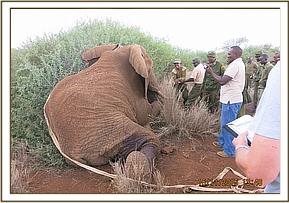

On physical examination the elephant had a penetrating wound to the right hind quarters and tip of tail. The wound was fresh probably about 24 hrs old and most likely caused by a spear. The wounds were then thoroughly cleaned using clean water and Hydrogen Peroxide. It was then lavaged using tincture of Iodine. Topical antibiotic cream and green clay was then applied into the wound to facilitate healing and avoid infection. The elephant was then injected with 100 ml Betamox L.A and 100 ml Dexamethasone at different sites intramuscularly. The entire operation lasted about 30 minutes.
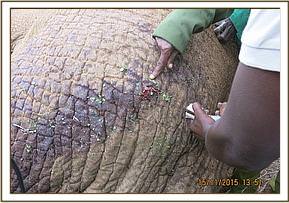

Reversal
The anaesthetic was reversed using Diprenorphine Hydrochloride (60mgs) into the ear vein. It took 7 minutes to get up and walk away from the site.
Prognosis
Good
CASE#6 POST-MORTEM OF AN ELEPHANT
Date of post-mortem: 19th November 2015
Species: Elephant
Age: 30-35 years
Sex: Male
Location: Amboseli
History
A dead elephant was reported to have been spotted within the park. A post-mortem was carried out and the following was observed.
General and Physical examination of the carcass
On general examination, the animal was in poor body condition and was on the left lateral side. No external injury was visible and both tusks were present.
Examination of the opened carcass
On opening the carcass, all body organs looked normal suggesting the condition was not chronic.
The G.I.T system had very little ingesta showing that the elephant had been off feed for a considerable period. The gut had plenty of bile suggesting starvation.
Samples collected
-Blood from the ear vein
-Blood smear
-Feacal sample from the g.i.t
Differential diagnosis
Bacterial/viral infection and malnutrition.

Acknowledgements
The Southern Conservation Area- Mobile Veterinary Unit is grateful to all individuals who played a role in assisting us towards achieving our goal. Many thanks to The David Sheldrick Wildlife Trust, The Samuel J and Ethel Lefrak charitable trust and The Kenya Wildlife Service for their continued support to this unit which aims at immediate response to clinical intervention, wildlife rescues and alleviating wildlife suffering.
